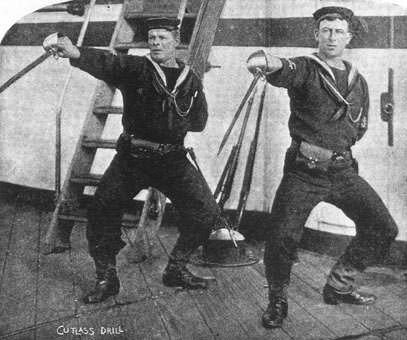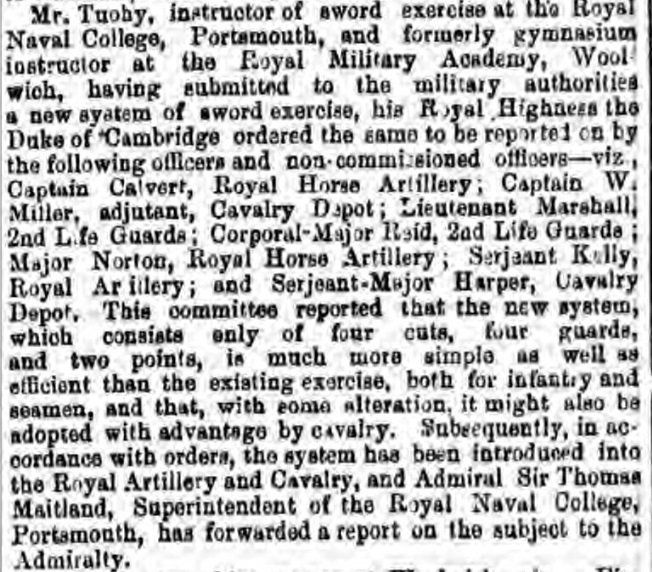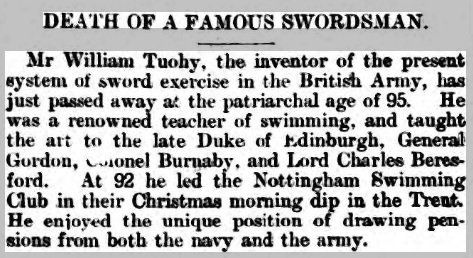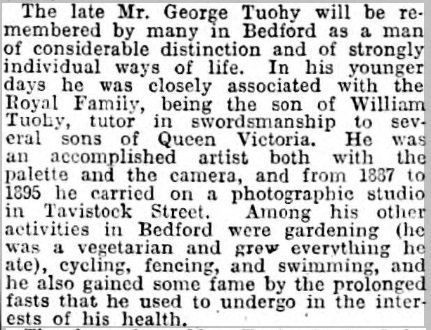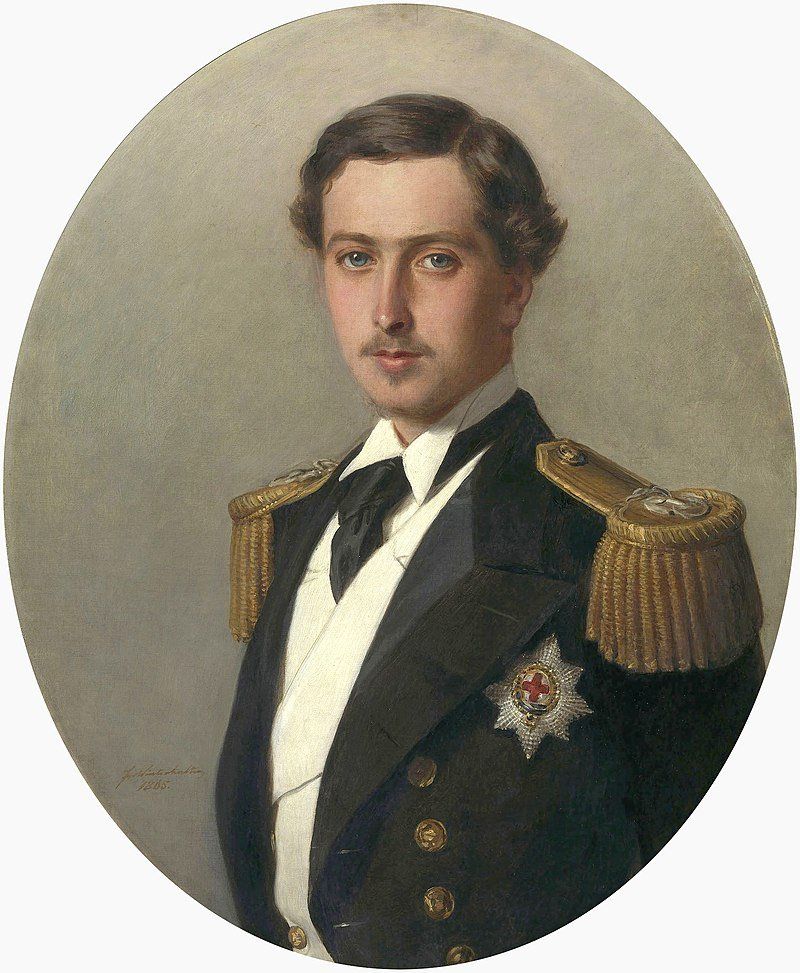The Revised Sword Exercise for the Royal Navy & British Armyof Sergeant William TuohyBy Matt Easton
The Revised Sword Exercise for the
Royal Navy & British Army
of Sergeant William Tuohy
By Matt Easton
Very few people alive today will have heard of William Tuohy before the publication of this article, unless they have read my 2014 book on Major Elliott's Art of Attack and Defence, where I briefly mentioned him. Probably nobody reading this article for the first time will realise that William Tuohy was almost as significant in the British Army & Royal Navy as Henry Angelo had been. I hope to change that.
Tuohy was known by hundreds of sailors and soldiers of the Royal Navy and British Army, as the source of the revised or new sword exercise in the mid-19th century. He personally taught scores and probably hundreds of them. He taught other instructors who went on to teach thousands of sailors and soldiers. I have 'rediscovered' him in the records and seek to give his name and memory due credit here.
Tuohy's new or revised sword exercise was first noted around 1856, being taught at the Royal Naval College in Portsmouth, where it gained enough approbation with the authorities that it was quickly adopted as the new regulation Cutlass Exercise in around 1857. It is freely available here in the 1859 edition of the Cutlass Exercise.
Tuohy's new method was adapted for the Infantry Sword Exercise (for infantry officers and anyone on foot with a sword, such as sappers and gunners) and finally for the cavalry in the new Cavalry Sword Exercise. You can study the 1875 edition of the Infantry Sword Exercise here.
This new Tuohy method, famous for simplifying British naval and military swordsmanship down to four cuts, four guards (parries) and two points (thrusts), was regulation across the Navy and Army from c.1857 to 1895. It was the first regulation system to bring in the High Seconde guard (shown above) as the engaging guard (or default fencing guard), later featured by Hutton, Waite, Allanson-Winn, Elliott and others.
Tuohy's new system officially replaced Henry Angelo Junior's sword exercise
(which had also been applied to cutlass first, then infantry and cavalry swords) dating from 1813 (1817 for infantry, 1819 for cavalry). Tuohy's system was in turn replaced by Masiello's method of 1895, which you can read more about in another of my articles.
Tuohy's method is documented completely in period manuals (such as the 1875 Infantry Sword Exercise) anonymously, but I have found without doubt that it was Tuohy's system, thanks to contemporary publications such as newspapers and journals, some of which I have reproduced below.
It was only through my research for a future publication about John Musgrave Waite that I accidentally discovered William Tuohy's name and thereafter researched his life and career. I was amazed that this man who was so important to the subject had been practically forgotten.
Tuohy was a contemporary of Waite and was similar in some ways. Both were private soldiers who rose to become non-commissioned officers and drill instructors, then going on to become private trainers outside the military in due course. They certainly knew each other personally and are mentioned taking part during the same events, even competing against each other in bouts. Waite was as a big 6 foot tall household cavalry trooper and Tuohy was a little artilleryman.
Both Waite and Tuohy developed their own systems which diverged from Angelo's then-regulation works. Waite's method being taught through his own school in London's Soho district, Tuohy's becoming Navy and Army regulation already by the time Waite was retiring from the Army to open his own school in the 1860s.
Tuohy lived to a very good age (95) for the period and spent the last decades of his life as a famous swimming instructor, teaching some of the most illustrious names of the day. More on that below.
Sergeant Tuohy's Sword Exercise
I will only summarize Tuohy's system here, as it is easy to read through yourself via the links provided, and to do that we can start with his own explanation text from the cutlass exercise diagram shown above:
Explanation
The large circle shows the direction of the cuts marked Cut 1, Cut 2, etc. The small circles show that the same may be delivered at the head body or leg.
The principal figure shows the defensive position called "Engage" being the best for a swordsman to be prepared to Attack or Defend when opposed to the sword, bayonet or pike.
The four small figures show the four guards or parries, for either cut or point, & the position from which the points are delivered without further preparation.
Tuohy's system was very much simpler than Angelo's. But it is clear that Tuohy's was deliberately simple and intended to produce fighting men quickly and effectively. As will be seen from the period assessments included in this article, it seems that Tuohy achieved that, demonstrably against people who had only been trained in the old (Angelo) sword exercise.
The real key to Tuohy's system seems to be that he taught a very basic system, with forceful and large strikes, and then got the students fencing at 'loose play' as quickly as possible with singlesticks and/or blunt practice swords.
He put emphasis on good cutting form and made the sword feats, specifically lead cutting, a part of the basic training. He also promoted training with both hands alternately and having loose play bouts between groups, in addition to the usual individual fights. Many modern HEMA practitioners will probably sympathize with and appreciate this approach.
Tuohy himself was fully trained in foil, broadsword and bayonet, and he is mentioned many times competing and fencing alongside some of the most highly-respected and competent fencers in Britain, including Gillemand, Shury, Chapman, Waite, Bushman, Prevost and others.
If his military system was simple, that was not for lack of knowledge or ability on his part - it must have been a deliberate and conscious decision. In his system he chose to boil down to the very basics what was taught to military recruits and focus on making them quickly into fighters, if not exactly fencers.
In terms of specifics, Tuohy decided to drop the upwards cuts (the old 3 and 4). Instead, his cuts are only downwards or horizontal, making the horizontal cuts into 3 and 4 (instead of the old 5 and 6). His guards are simple - Prime, Seconde, Tierce and Quarte. His engaging guard is High Seconde, which can defend any part simply by moving upwards or downwards, or outwards against Cut 2. This engaging guard was completely standard in the British Navy and Army from around this date, or possibly earlier, and it is the guard that Waite adapted for his system and is the first guard we see Hutton using in 1862. It was also common in other countries such as Austro-Hungary.
Understanding that by c.1860 this simple four cut, four parry, two thrust system was regulation in the British Navy and Military perhaps provides some useful context in understanding why there was an increase in the number of sabre treatises being published in Britain in the 1860s-90s, most prominently with Hutton, Waite, Burton and Allanson-Winn.
It seems that there was an appetite, probably led by the enthusiast/recreational fencers (both military and civilian) to return to something a bit more complex and comprehensive.
This also explains why the primary exponents Hutton, Waite and Burton all sought to produce new systems that were divergent from what had gone before (and were notably different to each other).
It is also clear that some of these people were associated with, or students of, the Angelo Academy of Arms, now led by William McTurk after Henry Angelo's death. Several of these people converged on George Chapman's London Fencing Club and influenced each other's development.
It is likely that the Angelo method continued to be taught, even if it was not regulation anymore. Certainly Angelo's old manual was still being published in the 1860s, after it had been phased out by the military.
In the end, Masiello's system became regulation in 1895 under the promotion of Colonel Fox, resulting in a totally different system which seems to have been terribly viewed in Britain.
While Tuohy's system was very simple, I can find barely any criticism anywhere of it, either in the press or in fencing treatises. Other fencers and authors may have wished for something more complex, but from the records available it seems that Tuohy's system was seen as fit for purpose for the military and superior to Angelo's manuals. In contrast, criticism of Masiello's system is voluminous and fervent in many publications of the time and I have uncovered evidence that by 1897 many military fencers were already abandoning it in favour of systems by Alfred Hutton and others.
William Tuohy's Life & Career
Tuohy's surname, of Irish origin, was spelled various ways in writings of the time, making research that much more challenging. He is sometimes recorded as Tohy and Tuohay for example (even Foohey!). Luckily, he left enough of a mark on British naval/military and sporting spheres that details of his life and endeavors were committed to print in many newspapers and journals.
Tuohy was born around 1807, allegedly the son of a Trooper in the 12th Light Dragoons, and joined the Army as a boy musician (sources vary between drummer and trumpeter), serving in the Royal Artillery. He rose through the ranks in the Artillery as he grew older and became a drill instructor of gymnastics and swordsmanship at the Royal Military Academy in Woolwich.
In the preface to Major Elliott's Art of Attack and Defence, it states of Elliott that "in his younger days, he [Elliott] was for a term of three years under the tuition of Serjeant [sic] Tuohy at the Garrison Gymnasium, Woolwich, who was a most enthusiastic and painstaking instructor; and to whom the opportunity is now taken to express the thanks of maturer age, for a bodily training which was afterwards of great advantage to his pupil."
As noted in my publication on Major Elliott's Art of Attack and Defence, which does show an abbreviated version of Tuohy's sword system, Tuohy must have been Elliott's instructor in the late 1840s or early 1850s. At that time Tuohy had not yet moved to the Navy and was based at the Royal Artilley's home in Woolwich.
In 1849, Tuohy of the Artillery was recorded at an assault-at-arms, competing in foil, sword vs bayonet and singlestick. In another account of 1849, Lloyd's Weekly Newspaper recounts Tuohy's singlestick bout against Corporal Jackson of the Life Guards, stating that, "the little artilleryman, by sleight and activity, got the best of his lengthy opponent by four hits to two."
Tuohy's stature and character are again referred to in Bell's Life in London and Sporting Chronicle of 30 June 1850, when he was described as the "ever-ready little artilleryman."
The Morning Chronicle of March 1855 records, "Sergeant Tuohy, of the Royal Artillery, who has for several years instructed the gentlemen cadets in the use of the sword and known by officers in the army."
In 1850 we see Tuohy competing at one of the assaults-at-arms alongside renowned fencing master and French Napoleonic Army veteran Leon Gillemand and well-known swordsman John Musgrave Waite. One of the judges being none other than George Chapman, expert fencer and author.
From Bell's Life in London and Sporting Chronicle - Sunday 07 July 1850:
In 1851 we again find Tuohy performing swordsmanship and also gymnastics at an assault of arms, described as being in his benefit. We can only assume from the wording that finances were not good and his friends in the military and fencing communities had rallied to aid his fortunes.
From the Kentish Independent - Saturday 06 September 1851:
In 1854 we see Tuohy again holding an assault-at-arms, with some important key colleagues. Gillemand, as already mentioned, was a famed French fencing instructor who had settled in Britain. Pierre Prevost was equally, or even more, famous. Also from France, he is the foil fencing master that John Musgrave Waite cites as his own teacher.
From the Kentish Independent - Saturday 04 February 1854:
In the Navy!
In 1855 William Tuohy joined the staff of the Royal Naval College in Portsmouth as an instructor and in 1856 revealed his new system of sword exercise. A committee was put together to come and study this new method and the Duke of Cambridge approved it for regulation in due course. In the next few years it was rolled out across the Navy first, then it was adapted for the Infantry, Artillery and Cavalry, being regulation for all the Navy and Army by the end of 1861.
From an article in the Portsmouth Times and Naval Gazette of 29 November 1856, we can see that at that time Tuohy was promoting his new system and training boys in it, pitching it as an improvement and reasonable replacement for Angelo's then-regulation system:
The Evening Mail of 1 December 1858 shows that by that date the new Cutlass Exercise under Tuohy was now being rolled out to naval drill instructors and had essentially replaced the old exercise of Angelo, at least in the Royal Navy. This was confirmed by the 1859 publishing of the Cutlass Exercise, according to Tuohy's system:
Tuohy's system came at an opportune time for the naval and military establishment, as it was carrying out reform and renewal after the logistical shambles of the Crimean War.
From the Morning Chronicle of 9 December 1861 we see that by this date Tuohy's system was being taught as regulation among the artillery and cavalry of the British Army:
Saunders's News-Letter - Friday 20 September 1861:
Morning Chronicle - Thursday 17 October 1861:
By 1863 Tuohy's system was already absorbed into cavalry regulation and some people considered it a better (or perhaps more practical for purpose) system for sailors and soldiers than Angelo's method which had preceded it.
From the Naval & Military Gazette and Weekly Chronicle of the United Service - Saturday 31 January 1863:
As an aside, at this point in the story it is worth noting (as I have done in many places) the strange anomaly of Sir Richard Francis Burton's 1876 'New Infantry Sword Exercise' (which was never adopted), which devotes a not inconsiderable percentage of its small size criticising the system of Angelo. This is especially amusing when we consider that Tuohy's system had already replaced Angelo's as regulation for the Navy and Army some 13-20 years prior to Burton's publication, but from Burton's text it is clear that he had only looked at a re-print of Angelo's old manual instead of the latest regulation work. This may explain why Burton's manual seems to have been almost completely ignored by contemporaries.
After a long career, Tuohy retired at around the age of 62 from the post of sword instructor at the Royal Naval College. However, this was not the end of his career; he had been for many years an active swimming instructor and that work would carry on for decades.
From the publication Broad Arrow of 10 April 1869:
In 1882, William Tuohy was around 76 years old and well retired. But we even then find him performing and speaking at an assault at arms, given for his benefit, presumably as a sign of gratitude and to financially assist him in his retirement.
From the Portsmouth Evening News - Saturday 13 May 1882:
Tuohy the Swimmer
William Tuohy, as mentioned, was most widely known in his time for swimming. He taught and demonstrated swimming and his whole family was involved in the activity. He taught swimming to some very notable individuals, as set out in this article from the Dundee Evening Telegraph of 18 December 1897:
From London Swimming Professors: Victorian Craftsmen and Aquatic Entrepreneurs. By D Day, 2010:
"Despite these reservations, some ex-army personnel demonstrated that they could become successful swimming professionals and the life course of William Tuohy demonstrates both his own longevity and the evolution of a kinship-based community of practice. In 1841, aged thirty-five, he was a ‘sergeant in the Royal Artillery’ at Woolwich where he was a ‘drill sergeant’ ten years later, although he was also giving swimming exhibitions. In 1850, ‘fancy swimming’ at Holborn included Sergeant Foohey (sic) with his ‘wonderful little boy’, and a year later Sergeant Tuohy was exhibiting with his two children, one two-and-a-half and the other four years old. These ‘little prodigies in the art of natation’ were introduced under a canopy of pink muslin covering a cot formed on floating mattresses and towed in by champion swimmers. By 1861, Tuohy was ‘instructor of sword exercise’ in the Royal Artillery College in Gosport, Hampshire, where he had been organising a swimming establishment since 1853. He was at Portsea in 1871, having retired from the army, hence his status as ‘Chelsea pensioner and fencing master’. Aged sixty-three he was living with thirty-six-year-old wife, Sarah, a ‘teacher of dancing’. By 1881, Tuohy had become a ‘swimming and fencing master’ and fifteen-year-old daughter Sarah, was his ‘swimming and fencing master’s assistant’. The whole family was involved in swimming by 1891. Tuohy was now calling himself a ‘swimming instructor’ and Sarah, his wife, was a ‘swimming instructress’, as were daughters Sarah and Mary, aged eighteen. William was living in Portsmouth when he died, aged ninety-five, in 1902, at which point both his daughters were both swimming instructresses in Nottingham."
"Despite these reservations, some ex-army personnel demonstrated that they could become successful swimming professionals and the life course of William Tuohy demonstrates both his own longevity and the evolution of a kinship-based community of practice. In 1841, aged thirty-five, he was a ‘sergeant in the Royal Artillery’ at Woolwich where he was a ‘drill sergeant’ ten years later, although he was also giving swimming exhibitions. In 1850, ‘fancy swimming’ at Holborn included Sergeant Foohey (sic) with his ‘wonderful little boy’, and a year later Sergeant Tuohy was exhibiting with his two children, one two-and-a-half and the other four years old. These ‘little prodigies in the art of natation’ were introduced under a canopy of pink muslin covering a cot formed on floating mattresses and towed in by champion swimmers. By 1861, Tuohy was ‘instructor of sword exercise’ in the Royal Artillery College in Gosport, Hampshire, where he had been organising a swimming establishment since 1853. He was at Portsea in 1871, having retired from the army, hence his status as ‘Chelsea pensioner and fencing master’. Aged sixty-three he was living with thirty-six-year-old wife, Sarah, a ‘teacher of dancing’. By 1881, Tuohy had become a ‘swimming and fencing master’ and fifteen-year-old daughter Sarah, was his ‘swimming and fencing master’s assistant’. The whole family was involved in swimming by 1891. Tuohy was now calling himself a ‘swimming instructor’ and Sarah, his wife, was a ‘swimming instructress’, as were daughters Sarah and Mary, aged eighteen. William was living in Portsmouth when he died, aged ninety-five, in 1902, at which point both his daughters were both swimming instructresses in Nottingham."
Tuohy's Passing
William Tuohy had obviously settled in Nottingham for quite some time, as mentioned above, though he died back in Portsmouth at the good age of 95. It is quite extraordinary to think that the same man who taught so many people swordsmanship and created the regulation system of three decades' service, also taught such an impressive array of individuals how to swim. He certainly seems to have lived a full life.
From the Nottingham Evening Post - Friday 28 February 1902:
From the Nottingham Evening Post - Friday 28 February 1902:
It is interesting to note that sources in 1902 still considered Tuohy the father of British Army swordsmanship, despite Masiello's method having become regulation, at least for infantry officers, in 1895.
From the Stonehaven Journal - Thursday 06 March 1902:
This obituary sums up many interesting details of Tuohy's life, from the Portsmouth Evening News - Monday 03 March 1902:
There is one final revelation in the tale of William Tuohy, which is revealed to us thanks to an obituary for his son, George Tuohy, in 1932. It transpires that alongside the many famous names William Tuohy tutored in swimming, he had in fact also instructed some of Queen Victoria's sons in swordsmanship. This was no small matter and really shows how embedded into the British naval/military system Tuohy and his method were.
From the Bedfordshire Times and Independent of 15 January 1932:
It was mentioned already in passing in the Portsmouth Evening News article of 13 May 1882 above that Tuohy had instructed H. R. H. The Duke of Edinburgh in the sword exercise. This makes sense, given that The Duke of Edinburgh, Prince Alfred Ernest Albert, born the fourth child of Queen Victoria, was a Royal Navy officer. Incredibly, he passed the examination in August 1858 and was made a midshipman on HMS Euryalus at only the age of 14, being promoted to Lieutenant in 1863. He must have undergone a period of training in swordsmanship, perhaps repeated, under Tuohy at the Royal Naval College during this period.
I hope that this article will have been of interest and that some people try out Tuohy's system. If you are looking for a military swordsmanship system that is quick to learn and easy to teach, this is it.
If you want to know what an average infantry officer, sailor, cavalryman or artilleryman would have been taught to do with their sword between c.1860 and c.1895, this is it.
It's also really useful to be familiar with when putting other 19th century British weapon systems into context, or perhaps as an introduction before tackling Waite's more advanced system. In tackling treatises like Waite's, or Hutton's various manuals, we should assume that the reader has conducted at least a beginner's course of foil and would be somewhat familiar with Tuohy's method.
Tuohy has been a fascinating character to research and I hope to be able to find out more about his life and work in due course. I think it is possible that we will find a photo or portrait of him some day, given his fame in the swimming world. Hopefully some more people will now mention his name and remember him. If you have any information to share about William Tuohy not already covered here then I will be happy to hear from you.
Period publication scans reproduced for academic study purposes, courtesy of the British Library Copyright and the British Newspaper Archive.




